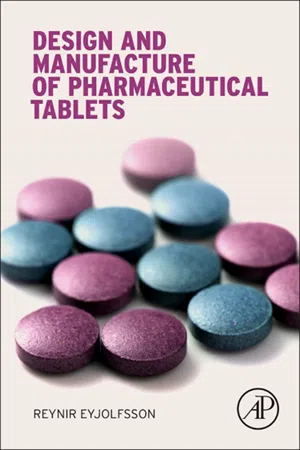1.1. General considerations [1, 2]
It has been stated that the discovery of new therapeutic entities always initiates excitement but even the best therapeutic entity in the world is of little value without an appropriate delivery system. The contributions of the formulation scientist are often either not well understood or taken for granted and thus remain unpraised. However, the drug entity and its delivery system cannot be separated.
Long time ago when this author entered into the realm of pharmacy the Danish Pharmacopeia (Pharmacopoeia Danica 1948) was official in Iceland. In it were numerous compositions and manufacturing methods for conventional pharmaceutical tablets. The formulations were practically always based on the same principle: lactose monohydrate was used as diluent and potato starch as diluent/disintegrant; granulation was done with gelatin mucilage as binder; the granulate was dried on trays, sieved, and lubricated with magnesium stearate/talc (1 + 9). These formulations were mostly compressed on single-punch tableting machines and did not generally suit high-speed rotaries. Tablets with poor technical properties were often obtained. Many pharmacies produced these tablets at the time, each using their own manufacturing “tricks.” No direct compression tablets or slow-release tablets were in the pharmacopeia. Impurity testing, good manufacturing practices, and dissolution tests still lay in the future, more than a decade away.
Today, the majority of pharmaceutical tablets are still manufactured by wet granulation using a variety of binders and other excipients but the principles are the same as in the old days. When embarking on a new project of designing a generic tablet it is always desirable to ascertain which excipients the originator or other producers of generics use. This may save a lot of time in terms of compatibility studies. Information on this is now readily available on the Internet, e.g., at www.rxlist.com or www.medicines.org.uk, although quantitative data are not given there. During the years this author has used the Repertorio Farmaceutico Italiano and L’Informatore Farmaceutico (may be obtained from www.amazon.it) extensively, not only because of his fondness of the beautiful Italian language but also because these sources furnished quantitative data of all ingredients in all pharmaceutical specialties registered in Italy. This practice, however, was abandoned some years ago. It is also highly recommended to screen the scientific literature about the chemical properties and perform functional group analysis of the active pharmaceutical ingredient’s (API’s) molecule in order to establish or at least be able to anticipate possible degradation pathways. Moreover, a particle size determination method for the API should be developed as soon as possible.
Knowledge of all excipients, even quant...
